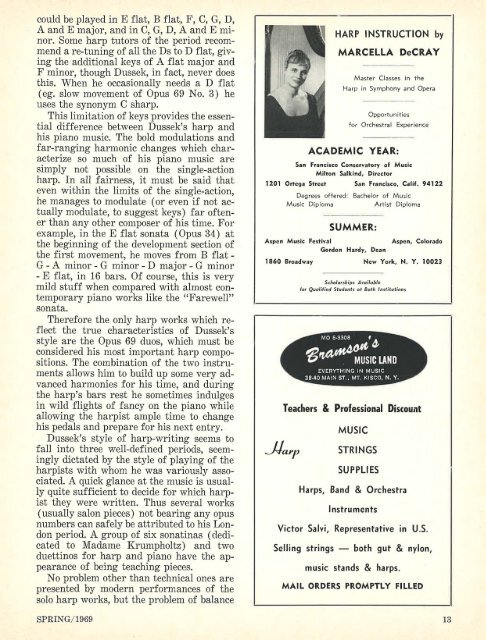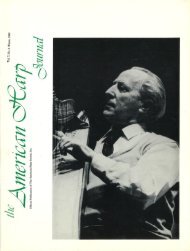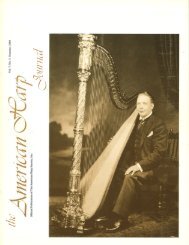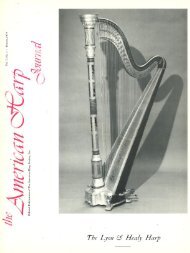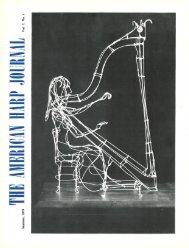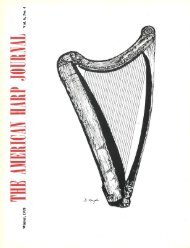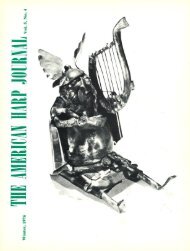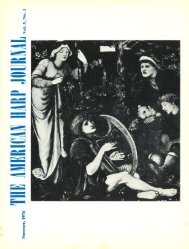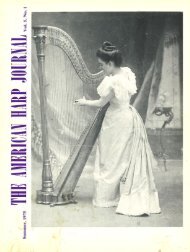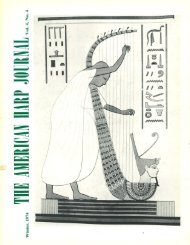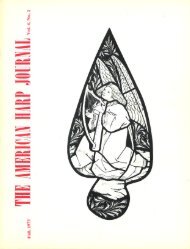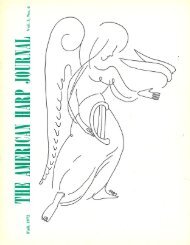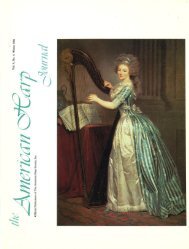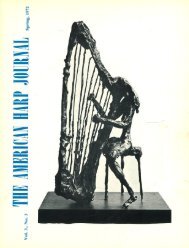AHJ, Vol. 2 No. 1, Spring 1969
AHJ, Vol. 2 No. 1, Spring 1969
AHJ, Vol. 2 No. 1, Spring 1969
Create successful ePaper yourself
Turn your PDF publications into a flip-book with our unique Google optimized e-Paper software.
could be played in E flat, B flat, F, C, G, D,<br />
A and E major, and in C, G, D, A and E minor.<br />
Some harp tutors of the period recommend<br />
a re-tuning of all the Ds to D flat, giving<br />
the additional keys of A flat major and<br />
F minor, though Dussek, in fact, never does<br />
this. When he occasionally needs a D flat<br />
( eg. slow movement of Opus 69 <strong>No</strong>. 3) he<br />
uses the synonym C sharp.<br />
This limitation of keys provides the essential<br />
difference between Dussek's harp and<br />
his piano music. The bold modulations and<br />
far-ranging harmonic changes which characterize<br />
so much of his piano music are<br />
simply not possible on the single-action<br />
harp. In all fairness, it must be said that<br />
even within the limits of the single-action,<br />
he manages to modulate ( or even if not actually<br />
modulate, to suggest keys) far oftener<br />
than any other composer of his time. For<br />
example, in the E flat sonata (Opus 34) at<br />
the beginning of the development section of<br />
the first movement, he moves from B flat -<br />
G -A minor - G minor - D major - G minor<br />
- E flat, in 16 bars. Of course, this is very<br />
mild stuff when compared with almost contemporary<br />
piano works like the "Farewell"<br />
sonata.<br />
Therefore the only harp works which reflect<br />
the true characteristics of Dussek' s<br />
style are the Opus 69 duos, which must be<br />
considered his most important harp compositions.<br />
The combination of the two instruments<br />
allows him to build up some very advanced<br />
harmonies for his time, and during<br />
the harp's bars rest he sometimes indulges<br />
in wild flights of fancy on the piano while<br />
allowing the harpist ample time to change<br />
his pedals and prepare for his next entry.<br />
Dussek's style of harp-writing seems to<br />
fall into three well-defined periods, seemingly<br />
dictated by the style of playing of the<br />
harpists with whom he was variously associated.<br />
A quick glance at the music is usually<br />
quite sufficient to decide for which harpist<br />
they were written. Thus several works<br />
( usually salon pieces) not bearing any opus<br />
numbers can safely be attributed to his London<br />
period. A group of six sonatinas ( dedicated<br />
to Madame Krumpholtz) and two<br />
duettinos for harp and piano have the appearance<br />
of being teaching pieces.<br />
<strong>No</strong> problem other than technical ones are<br />
presented by modern performances of the<br />
solo harp works, but the problem of balance<br />
SPRING/<strong>1969</strong><br />
HARP INSTRUCTION by<br />
MARCELLA DeCRAY<br />
Master Classes in the<br />
Harp in Symphony and Opera<br />
Opportunities<br />
for Orchestral Experience<br />
ACADEMIC YEAR:<br />
San Francisco Conservatory of Music<br />
Milton Salkind, Director<br />
1201 Ortega Street San Francisco, Calif. 94122<br />
Degrees offered: Bachelor of Music<br />
Music Diploma<br />
Artist Diploma<br />
SUMMER:<br />
Aspen Music Festival<br />
Gordon Hardy, Dean<br />
Aspen, Colorado<br />
1860 Broadway New York, N. Y. 10023<br />
Scholarships Available<br />
for Qualified Students at Both Institutions<br />
Teachers & Professional Discount<br />
MUSIC<br />
STRINGS<br />
SUPPLIES<br />
Harps, Band & Orchestra<br />
Instruments<br />
Victor Salvi, Representative in U.S.<br />
Selling strings -<br />
both gut & nylon,<br />
music stands & harps.<br />
MAIL ORDERS PROMPTLY FILLED<br />
13


